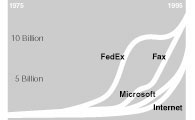INCREASING RETURNS
During its first 10 years…
…Microsoft’s profits were negligible. Its profits rose above the background noise of Wall Street only around 1985. But once they began to rise, they exploded. A chart of Microsoft’s cornucopia of profits is an exponentially booming curve, one that parallels several other rising stars in the network economy.
Federal Express experienced a similar trajectory: years of minuscule profit increases, slowly ramping up to an invisible threshold, and then surging skyward in a blast sometime during the early 1980s.
The story of fax machines is likewise a tale of a 20-year-long overnight success. After two decades of marginal success, the number of fax machines quietly crossed the point of no return during the mid-1980s–and the next thing you know, they were everywhere.

Network organizations experience small gains while thieir network is being seeded. Once the network is established, explosive growth follows with relatively little additional genius.
The archetypal case of a success explosion in a network economy is the internet itself. As any proud old-time nethead will be happy to explain, the internet was a lonely (but thrilling!) cultural backwater for two decades before it showed up on the media radar. A graph of the number of internet hosts worldwide, starting in the 1970s, stays barely above the bottom line, until around 1991, when the global tally of hosts suddenly mushroomed, exponentially acting upward to take over the world.
The curves of Microsoft, the internet, fax machines and FedEx (I owe Net Gain author John Hagel credit for these four examples) are templates of exponential growth, compounding in a biological way. Such curves are almost the definition of a biological system. That’s one reason the network economy is often described most accurately in biological terms. Indeed, if the web feels like a frontier, it’s because for the first time in history we are witnessing biological growth in technological systems.

